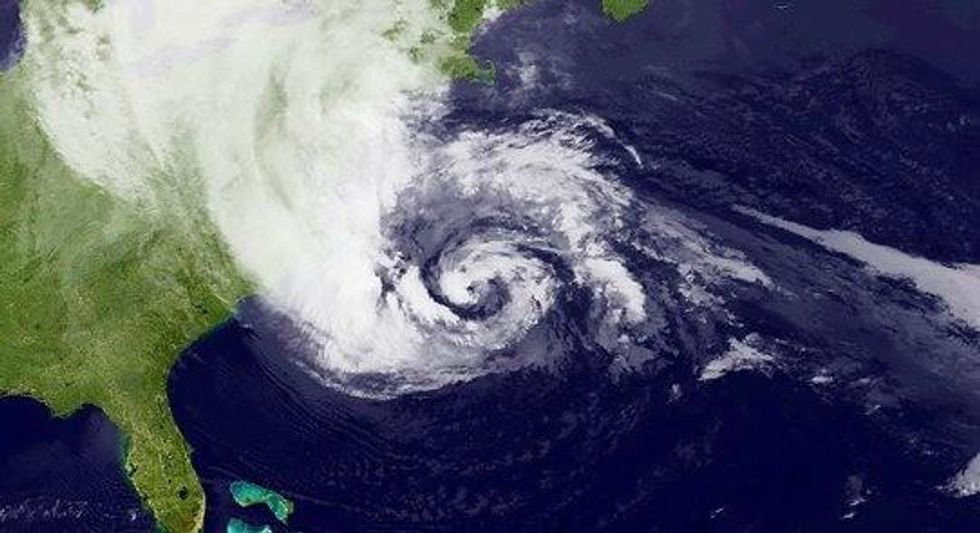Why 'Frankenstorm' Is Just Right for Hurricane Sandy
Watching Sandy on her careening path toward the Eastern Seaboard scares me more than it would have 15 months ago. That's because my home state took the brunt of Irene, last year's "sprawling," "surly," "record-breaking" Atlantic storm. I know now exactly how much power a warm sea can contain and how far that pain can spread.

And in the process, feeling that fear, I begin to sense what the future may be like, as more and more of the world finds itself facing ever-more-frequent assaults from the amped-up forces of the not-so-natural world.
Our relationship to the world around us is shifting as fast as that world is shifting.
You can't, as the climate-change deniers love to say, blame any particular hurricane on global warming. They're born, as they always have been, when a tropical wave launches off the African coast and heads out into the open ocean. But when that ocean is hot--and at the moment sea surface temperatures off the Northeast are five degrees higher than normal--a storm like Sandy can lurch north longer and stronger, drawing huge quantities of moisture into its clouds, and then dumping them ashore.
Last year that dumping happened across Vermont. In some places we broke absolutely every rainfall record. It turned our streams and rivers into cataracts that took out 500 miles of state highway. A dozen towns were left completely cut off from the rest of the world, relying on helicopters to drop food. I know the odds are slim that we'll find ourselves in the bull's-eye again. But someone will.
This time the great damage may be along the coast. Even as we've built up our coastal populations, sea level has begun to climb. There are already cities along the coast that flood easily at the month's high tide. This storm may hit when the moon is full, and it may dump so much rain that the water will be coming from both directions. Or maybe across the Appalachian highlands will be where it does its biggest damage, mixing with an inland storm front to dump snow on forests still in leaf. But someplace is going to take it on the chin, maybe harder than it ever has before.
And that's the world we live in now. James Hansen, the NASA climatologist, published a paper earlier this year showing how the seemingly small one degree we've already warmed the earth has made extreme weather far more likely. The insurance industry has published a series of warnings in recent years saying the same thing. The world grows steadily more unpredictable, and hence we grow less comfortable in it.
You see the same thing on much smaller scales. In Vermont this fall we had our first deaths ever from Eastern equine encephalitis, a mosquito-borne disease that the experts had predicted would come with a warming climate. They were right, and now when you go out to weed the garden, the dusk carries with it a slight whiff of apprehension it never did before.
Our relationship to the world around us is shifting as fast as that world is shifting. "Frankenstorm" is the right name for Sandy, and indeed for many other storms and droughts and heat waves now. They're stitched together from some spooky combination of the natural and the unnatural. Some state will doubtless bear the brunt of this particular monster, but it also will do its damage to everyone's state of mind.
An Urgent Message From Our Co-Founder
Dear Common Dreams reader, The U.S. is on a fast track to authoritarianism like nothing I've ever seen. Meanwhile, corporate news outlets are utterly capitulating to Trump, twisting their coverage to avoid drawing his ire while lining up to stuff cash in his pockets. That's why I believe that Common Dreams is doing the best and most consequential reporting that we've ever done. Our small but mighty team is a progressive reporting powerhouse, covering the news every day that the corporate media never will. Our mission has always been simple: To inform. To inspire. And to ignite change for the common good. Now here's the key piece that I want all our readers to understand: None of this would be possible without your financial support. That's not just some fundraising cliche. It's the absolute and literal truth. We don't accept corporate advertising and never will. We don't have a paywall because we don't think people should be blocked from critical news based on their ability to pay. Everything we do is funded by the donations of readers like you. Will you donate now to help power the nonprofit, independent reporting of Common Dreams? Thank you for being a vital member of our community. Together, we can keep independent journalism alive when it’s needed most. - Craig Brown, Co-founder |

And in the process, feeling that fear, I begin to sense what the future may be like, as more and more of the world finds itself facing ever-more-frequent assaults from the amped-up forces of the not-so-natural world.
Our relationship to the world around us is shifting as fast as that world is shifting.
You can't, as the climate-change deniers love to say, blame any particular hurricane on global warming. They're born, as they always have been, when a tropical wave launches off the African coast and heads out into the open ocean. But when that ocean is hot--and at the moment sea surface temperatures off the Northeast are five degrees higher than normal--a storm like Sandy can lurch north longer and stronger, drawing huge quantities of moisture into its clouds, and then dumping them ashore.
Last year that dumping happened across Vermont. In some places we broke absolutely every rainfall record. It turned our streams and rivers into cataracts that took out 500 miles of state highway. A dozen towns were left completely cut off from the rest of the world, relying on helicopters to drop food. I know the odds are slim that we'll find ourselves in the bull's-eye again. But someone will.
This time the great damage may be along the coast. Even as we've built up our coastal populations, sea level has begun to climb. There are already cities along the coast that flood easily at the month's high tide. This storm may hit when the moon is full, and it may dump so much rain that the water will be coming from both directions. Or maybe across the Appalachian highlands will be where it does its biggest damage, mixing with an inland storm front to dump snow on forests still in leaf. But someplace is going to take it on the chin, maybe harder than it ever has before.
And that's the world we live in now. James Hansen, the NASA climatologist, published a paper earlier this year showing how the seemingly small one degree we've already warmed the earth has made extreme weather far more likely. The insurance industry has published a series of warnings in recent years saying the same thing. The world grows steadily more unpredictable, and hence we grow less comfortable in it.
You see the same thing on much smaller scales. In Vermont this fall we had our first deaths ever from Eastern equine encephalitis, a mosquito-borne disease that the experts had predicted would come with a warming climate. They were right, and now when you go out to weed the garden, the dusk carries with it a slight whiff of apprehension it never did before.
Our relationship to the world around us is shifting as fast as that world is shifting. "Frankenstorm" is the right name for Sandy, and indeed for many other storms and droughts and heat waves now. They're stitched together from some spooky combination of the natural and the unnatural. Some state will doubtless bear the brunt of this particular monster, but it also will do its damage to everyone's state of mind.

And in the process, feeling that fear, I begin to sense what the future may be like, as more and more of the world finds itself facing ever-more-frequent assaults from the amped-up forces of the not-so-natural world.
Our relationship to the world around us is shifting as fast as that world is shifting.
You can't, as the climate-change deniers love to say, blame any particular hurricane on global warming. They're born, as they always have been, when a tropical wave launches off the African coast and heads out into the open ocean. But when that ocean is hot--and at the moment sea surface temperatures off the Northeast are five degrees higher than normal--a storm like Sandy can lurch north longer and stronger, drawing huge quantities of moisture into its clouds, and then dumping them ashore.
Last year that dumping happened across Vermont. In some places we broke absolutely every rainfall record. It turned our streams and rivers into cataracts that took out 500 miles of state highway. A dozen towns were left completely cut off from the rest of the world, relying on helicopters to drop food. I know the odds are slim that we'll find ourselves in the bull's-eye again. But someone will.
This time the great damage may be along the coast. Even as we've built up our coastal populations, sea level has begun to climb. There are already cities along the coast that flood easily at the month's high tide. This storm may hit when the moon is full, and it may dump so much rain that the water will be coming from both directions. Or maybe across the Appalachian highlands will be where it does its biggest damage, mixing with an inland storm front to dump snow on forests still in leaf. But someplace is going to take it on the chin, maybe harder than it ever has before.
And that's the world we live in now. James Hansen, the NASA climatologist, published a paper earlier this year showing how the seemingly small one degree we've already warmed the earth has made extreme weather far more likely. The insurance industry has published a series of warnings in recent years saying the same thing. The world grows steadily more unpredictable, and hence we grow less comfortable in it.
You see the same thing on much smaller scales. In Vermont this fall we had our first deaths ever from Eastern equine encephalitis, a mosquito-borne disease that the experts had predicted would come with a warming climate. They were right, and now when you go out to weed the garden, the dusk carries with it a slight whiff of apprehension it never did before.
Our relationship to the world around us is shifting as fast as that world is shifting. "Frankenstorm" is the right name for Sandy, and indeed for many other storms and droughts and heat waves now. They're stitched together from some spooky combination of the natural and the unnatural. Some state will doubtless bear the brunt of this particular monster, but it also will do its damage to everyone's state of mind.

